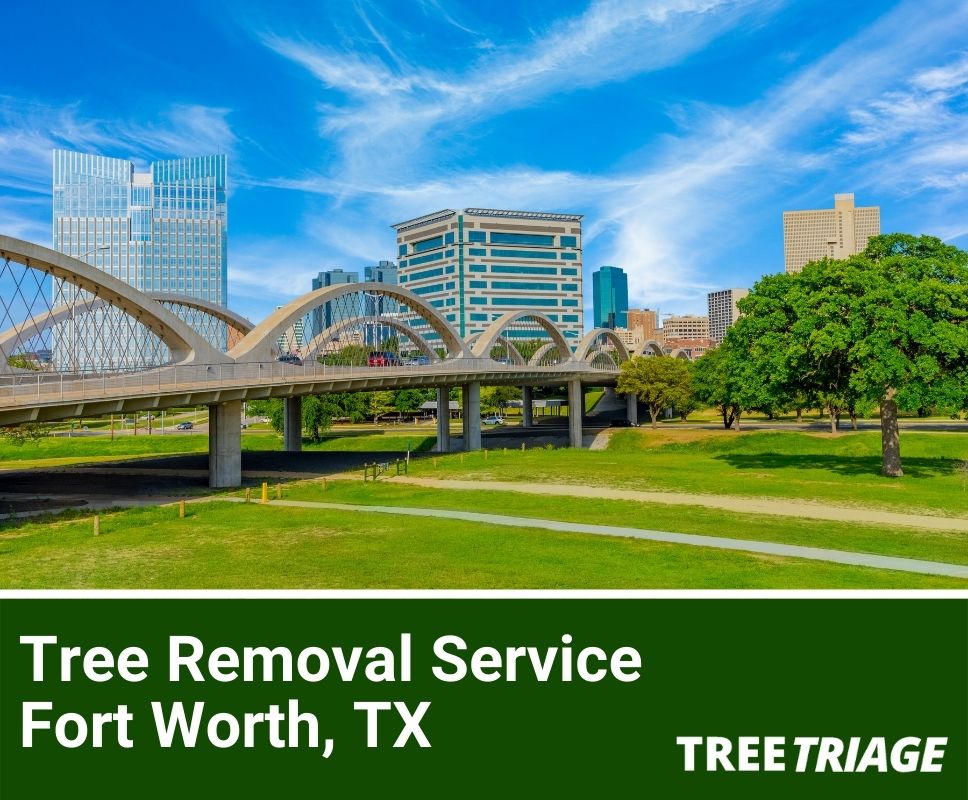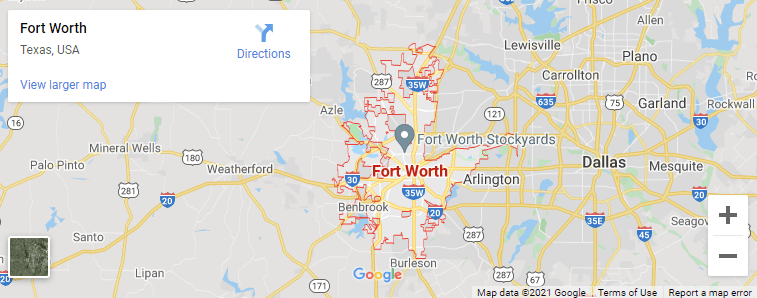Contents (Click To Jump)
- 1 What Are The Most Common Tree Issues In Fort Worth?
- 2 Does The City of Fort Worth Provide Any Assistance In Tree Removal Problems?
- 3 Who Is Responsible For Fallen Tree Removal In Fort Worth?
- 4 How Does The Soil Affect Trees In Fort Worth?
- 5 Does Weather Affect Tree Health In Fort Worth?
- 6 What If Dead Trees Are Near Power Lines In Fort Worth?
- 7 How Much Does Tree Removal Usually Cost in Fort Worth?
What Are The Most Common Tree Issues In Fort Worth?
When people think of your Fort Worth home, they likely misinterpret it for the parts of Texas that don’t get the pleasure of enjoying all the seasons the year can bring you — including those hot and muggy summer months and those wintertime blues. But we all know the highs and lows that come along with Fort Worth weather, and so we also know not every tree will survive its unpredictability despite maintaining 30% tree canopy coverage citywide.
For this reason, some of the most common trees in Fort Worth are:
- Shumard Red Oak
- Chinquapin Oak
- Live Oak
- Bur Oak
- Lacey Oak
- Bald Cypress
- Cedar Elm
What many don’t know, however, is that there are rules and restrictions to abide by if or when you are thinking about taking any trees down — even on your own property.
To protect its tree population, the city of Fort Worth insists no permit is required to remove a dead/dying, diseased, or hazardous tree on a single unit of private property on less than 1 acre. However, they require a permit if it’s on more than 1 acre, has multiple unit homes, or is a significant tree, heritage tree, or any tree with a breast height of 6 or more inches.
Here are some common Fort Worth tree issues that can lead to required tree removals:
- Bacterial Leaf Scorch. This is a tree disease that, left untreated, can become fatal over time to Fort Worth landscapes. It can take several years to die, leaving you ample time to respond before it’s too late, but many people confuse BLS signs with other less-fatal tree stressors.
Signs and symptoms include early browning on its leaves, marginal leaf necrosis (brown tips and premature yellowing), and leaf defoliation (falling before it’s supposed to). These symptoms continue to occur every year until branch by branch and leaf by leaf, every part of the tree browns, dies, and eventually falls off.
Unfortunately, BLS isn’t curable, so you will either want to remove your tree and plant another in its place or get root injections done annually to preserve its lifetime. Replacement is more ideal, and since it can take your tree as long as 10 years to die in most cases, planting a non-susceptible tree early on will allow you to get a good start on it before the original meets its fate.
Susceptible trees in Fort Worth include oak, maples, birch, elm, bur, water, live, and more. However, white oaks are more resistant than red oaks, and Texas buckeyes are also recommended. - Oak Wilt. This is a fungal disease that interrupts the flow of water and nutrients in your tree’s vessel, causing brown or yellow discoloration in your leaves’ veins. This tree disease can cause a quick decline that can even lead to death in as little as 4 months in some cases.
Since Oak Wilt is transmitted through insects like beetles (insects that are most active in Fort Worth in springtime between February and July), monitoring your trees regularly is necessary for their protection. This will allow you to detect signs and issues early and proceed with tree removals, insecticides, root graft eliminations, and injections, where necessary, to preserve your tree landscape.
White oak trees like bur oak and chinquapin oak are the most ideal Fort Worth tree options for their resistance to Oak Wilt, and a distance of 60 feet also helps with spread prevention — red oak and live oak are the most susceptible in our city. - Fire Blight Disease. Typically found in fruit trees, this disease refers to the rapid decline and “blackening” of foliage and blooms. The disease can manifest inside your tree and spread through rather quickly, so immediate recognition of signs and symptoms in the bloom of February and a must.
Look out for blackening and wilting leaves, cankers, splitting wounds, and milky substances leaking for your tree to try and identify the problem before it’s too late. We won’t be able to cure your problem, but we can certainly prevent it from affecting the rest of your landscape.
This disease is most egregious to apple and pear trees — with apple trees being one of the most common in eastern Texas and pear trees more common on the north/western end. Since Fort Worth is in the north and “Where the West Begins,” this means pears are your biggest concern. Ornamental Pear trees, in particular, should be regularly checked for Fire Blight signs. - Hypoxylon Canker. This disease can be fatal for most of our Fort Worth native trees, making it a common problem in our area. Considered highly transmissible and known to spread rather quickly, stressed and weak trees can be considerably more vulnerable to this fate than healthy ones — making insufficient care during a drought even more of a danger to your landscape than you may have thought.
Keep an eye out for a crusty red/brown or yellow/green discoloration that may be turning grey in areas of your tree to catch it in its early stages. However, signs like large and small patches on branches or the trunk can indicate it’s time for our tree experts to head over for removal before another plant’s life becomes in danger as well. Our arborists should immediately inspect any signs of weakening or deterioration just in case.
Some of the more susceptible native trees include sycamore, oak, elm, and pecan. However, they can be easily prevented with enough love and care during drought season, meaning special attention to sufficient watering and tending to wounds promptly. Otherwise, all we can do for your tree is remove it from your property.
Does The City of Fort Worth Provide Any Assistance In Tree Removal Problems?
The City of Fort Worth does not offer any assistance with the private property removal of trees. Still, it does offer assistance if a public tree falls on private property and if private property trees fall onto public property (up until the private property line — rest is the property owner’s responsibility). They also assist in providing you with trees you can plant on the parkway (area between curb and sidewalk owned by the city). Trees acquired by the city are expected to be properly taken care of by residents for two years before the city takes over maintenance.
When fallen trees or storm-damaged limbs make their way into public property, you must contact Forth Worth’s Forestry Section for Hazards immediately.
Who Is Responsible For Fallen Tree Removal In Fort Worth?
The responsibility of fallen tree removals depends solely on the owner of the property the tree has fallen on. If it falls on city property, the city will be quick to take care of the problem (even require you to go through the proper channels before you can do anything about it yourself).
However, there’s much more that goes into it, and we are glad to help you better understand.
If you’re a homeowner?
Yes, the trees on a homeowner’s property are the homeowner’s responsibility. However, if it falls into another person’s property (neighbor or public) due to a storm or similar, it becomes the other person’s responsibility to remove it. Before moving forward with tree removals of your own, you will need to fill out a Fort Worth Tree Removal application and get a permit.
If you’re a renter?
While general maintenance and upkeep around a renter’s property are typically expected (or forced by contract), big projects like tree removal (that require significant cost and responsibility) are given to the landlord in Fort Worth areas, just as other big structural problems would be — after all, isn’t that the beauty of renting over owning?
If you’re a landlord?
Much like a homeowner, a landlord has sole ownership over the property (in this case, one or more rental units instead of one home). Therefore, it has the same responsibilities when it comes to tree removals.
If you’re a neighbor?
This can go one of two ways — either you share a tree with your neighbor, and it has fallen, or a tree from your property has fallen onto your neighbor’s property.
Trees on a boundary line are joint property, meaning you both are responsible for sharing tree removal costs, making decisions on tree removals in general, and more. However, a tree that falls onto a neighbor’s property due to natural or weather-related causes becomes the responsibility of your neighbor. Trees that fall onto your neighbor’s property due to poor care and maintenance are the responsibility of the original tree owner, who is also lliable for damage costs if any occur.
How Does The Soil Affect Trees In Fort Worth?
In Fort Worth, the most common types of soil present are sandy loams and clay-rich soils. With this being said, you want to get a soil test to understand which one is most present on your property because the two react differently to weather conditions — affecting your tree accordingly.
Clay-rich soils do not need as much watering are slow to dry out after rainfall/watering, whereas sandy soil requires frequent watering because they drain quickly. One or the other can contribute to over or under-watering your trees.
Does Weather Affect Tree Health In Fort Worth?
The weather in Fort Worth can certainly play a significant part in the health of your trees. Since Fort Worth usually experiences all seasons, native trees typically survive the average highs between 57 and 91 and the average lows of 33 to 70, but there are the occasional surprises that arise — for instance, the brutal winter storms occasionally rock February’s blooming trees.
Likewise, tornadoes can be problematic. Most active in late spring (peaking in June), tornadoes can cause extensive damage to healthy Fort Worth trees. Not to say they aren’t vulnerable all year round, because they can happen at any time in the area.
What If Dead Trees Are Near Power Lines In Fort Worth?
Any trees that pose any power line/utility interfering hazards should be reported to Fort Worth’s electrical utility provider Oncor. While trees interfering with the power line from the pole to your house are the property owner’s responsibility, it can be dangerous (never approach or touch!), so electricians and their tree removers should be contacted immediately.
How Much Does Tree Removal Usually Cost in Fort Worth?
It’s important to know that tree removal costs have some cost factors in Fort Worth that influence their range, so the city average can easily be influenced by those factors. With that being said, the average tree removal cost in Fort Worth has a wide range of $260 to $1,140, with the average cost sitting around $700.
Fallen/standing trees
Whether you are looking to remove a tree that is still standing or already has fallen can play a big part in how much you pay out to get the tree removed from your property. If your tree has fallen, fixed fees average around $237.50 under 30 feet and range from $125.00 to $350.00. A still-standing tree has a fixed-rate fee of $418.68 under 30 feet and a cost range between $353.85 and $483.51.
Tree height
In addition, your tree removal cost depends on the height of your tree. With fallen/standing tree costs in mind, tree height remains that same at 30 feet and under but will begin to increase by an average of $4.25 per foot of height or range from $3.50 to $5. This means you can expect from $360 to $640 for 40 feet, $540 to $960 for 60 feet, and $720 to $1,280 for 80 feet.
Stump removal
If you are looking for only a tree stump to be removed, you’re looking at a lot less in tree removal costs. Pricing ranges from $2.96 to $3.19 per linear inch (stump diameter) and typically includes stump grinding.






